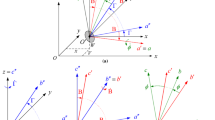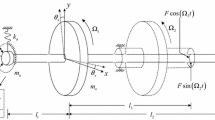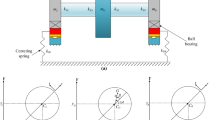Abstract
This paper is focused on the relationship between rigid body translation and rigid body precession in a squeeze film damper–rigid-rotor system with unsymmetrical stiffness supports. Two cases are considered: the precession motion non-resonance and internal resonance when translation motion occur primary resonant. In the first case, the amplitudes of translation and precession can be connected with an integration parameter about rotor parameters such as geometric size, stiffness, and mass. Some combination of system parameters will make the amplitudes of precession motion reach the same magnitude of the amplitudes of translation motion, so this integration parameter become an index to reflect the precessional motion degree, it is can be used to judge the feasibility of neglecting processional motion and simplifying asymmetry rotor as reasonable symmetry model. In the second case, the translation motion and precessional motion are strongly coupled, the vibration energy transfer between two kind of motion and the system occur internal resonant, which is possible appear in the rotor with cantilever disk. Each of case may appear nonlinear phenomenon, which is closely related with system parameters. The bifurcation analysis by using singularity methods is carried out to delimit the range of applicative operation parameters to avoid harmful phenomenon in unsymmetrical rotor system. The results of this paper provide a theoretical foundation for the convenient model simplification judgment and parameters optimization of the squeeze film damper-unsymmetrical rotor systems.










Similar content being viewed by others
Abbreviations
- \(a_{1,2}\) :
-
Non-dimensional amplitudes in complex coordinates
- \(\bar{{a}}_{1,2} \) :
-
Non-dimensional amplitudes in principal coordinates
- B :
-
Non-dimensional bearing parameter
- \({B}'\) :
-
Non-dimensional bearing parameter
- c :
-
Clearance of squeeze film damper (m)
- \({c}'\) :
-
Damping of the supports (N s/m)
- e :
-
Radial displacement of journal (m)
- \(F_{cx}\) :
-
Oil film force in x-direction (N)
- \(F_{cy}\) :
-
Oil film force in y-direction (N)
- \(F_{r}\) :
-
Oil film force in radial direction (N)
- \(F_{t}\) :
-
Oil film force in tangential direction (N)
- \(\bar{{F}}_r \) :
-
Non-dimensional oil film force in radial direction
- \(\bar{{F}}_t \) :
-
Non-dimensional oil film force in tangential direction
- \(J_{d}\) :
-
Equivalent equatorial moment of inertia (\(\hbox {kg m}^{2}\))
- \(J_{p}\) :
-
Equivalent polar moment of inertia (\(\hbox {kg m}^{2}\))
- K :
-
Ratio of stiffness coefficient
- \(k_{1}\) :
-
Equivalent stiffness coefficient of the left support (N/m)
- \(k_{2}\) :
-
Equivalent stiffness coefficient of the right support (N/m)
- L :
-
Length of squeeze film damper (m)
- \(l_{1}\) :
-
Distance from the disk to the left support (m)
- \(l_{2}\) :
-
Distance from the disk to the right support (m)
- m :
-
Equivalent mass of the rotor (kg)
- \(p_{1,2}\) :
-
Elements of modal matrix
- \(Q_{1,2}\) :
-
Non-dimensional displacements in complex coordinates
- \(\bar{{Q}}_{1,2} \) :
-
Non-dimensional displacements in principal coordinates
- \(q_{11,22}\) :
-
Elements of inverse matrix of modal matrix
- R :
-
Radius of the journal (m)
- r :
-
Non-dimensional radial displacement of journal
- t :
-
Time (s)
- U :
-
Non-dimensional integrated unbalance value
- \(\alpha _{1,2} \) :
-
Non-dimensional stiffness parameters
- \(\gamma \) :
-
Length parameter
- \(\delta \) :
-
Unbalance value (kg m)
- \(\zeta \) :
-
Non-dimensional damping parameter
- \(\eta \) :
-
Non-dimensional moment of inertia parameter
- \(\theta _{1,2} \) :
-
Phase angles of vibration responses
- \(\kappa \) :
-
Non-dimensional stiffness parameters
- \(\mu \) :
-
Kinetic viscosity coefficient of oil (\(\hbox {N s/m}^{2}\))
- \(\xi _{1,2} \) :
-
Non-dimensional damping parameters
- \(\tau \) :
-
Non-dimensional time
- \(\psi \) :
-
Angular displacement of journal (rad)
- \(\omega \) :
-
Rotor speed (rad/s)
- \(\omega _{1,2}\) :
-
Principal frequencies
- \(\omega _c \) :
-
Natural frequency of rigid rotor on retainer springs (rad/s)
- \(\varOmega \) :
-
Speed parameter
- \(\bar{{\varOmega }}\) :
-
Ratio of rotor speed
References
Cooper, S.: Preliminary investigation of oil films for control of vibration. Lubr. Wear Conven. 305–315 (1963)
Della Pietra, L., Adiletta, G.: The squeeze film damper over four decades of investigations. Part II : rotordynamic analyses with rigid and flexible rotors. Shock Vib. Dig. 34(2), 97–126 (2002)
Jiao, Y., Chen, Z., Xia, S., et al.: Period solution bifurcation and stability analysis of nonlinear squeeze film damper rotor system. Mech. Sci. Technol. 23(7), 879–882 (2004)
Zhu, C.S., Robb, D.A., Ewins, D.J.: Analysis of the multiple-solution response of a flexible rotor supported on non-linear squeeze film dampers. J. Sound Vib. 252, 389–408 (2002)
Qin, W., Zhang, J., Ren, X.: Response and bifurcation of rotor with squeeze film damper on elastic support. Chaos Solitons Fractals 39, 188–195 (2009)
Bonello, P., Brennan, M.J., Holmes, R.: Non-linear modeling of rotor dynamic systems with squeeze film dampers—an efficient integrated approach. J. Sound Vib. 249(4), 743–773 (2002)
Zhao, J.Y., Hahn, E.J.: Subharmonic, quasi-periodic and chaotic motions of a rigid rotor supported by an eccentric squeeze film damper. Proc. Inst. Mech.Eng. Part C J. Mech. Eng. Sci. 207, 383–392 (1993)
Chu, F., Holmes, R.: Efficient computation on nonlinear responses of a rotating assembly incorporating the squeeze-film damper. Comput. Methods Appl. Mech. Eng. 164, 363–373 (1998)
Meng, G., Xia, N.: Bifurcation and chaos responses of a flexible rotor-squeeze film damper system. Acta Aeronautica et Astronautica Sinica 24(1), 42–45 (2003)
He, E., Ren, X., Qin, W.: Chaotic response of cracked rotor supported on squeeze film damper and the routes to chaos. Chin. J. Aeronaut. 15(3), 145–149 (2002)
Lin, F., Zhang, T., Meng, G.: Nonlinear characteristics of the rub-impact response of a rotor system supported on squeeze film dampers. J. Vib. Shock 23(1), 12–16 (2004)
Inayat-Hussain, J.I., Kanki, H., Mureithi, N.W.: Stability and bifurcation of a rigid rotor in cavitated squeeze-film dampers without centering springs. Tribol. Int. 34, 689–702 (2001)
Inayat-Hussain, J.I.: Bifurcations of a flexible rotor response in squeeze-film dampers without centering springs. Chaos Solitons Fractals 24, 583–596 (2005)
Inayat-Hussain, J.I.: Bifurcations in the response of a flexible rotor in squeeze-film dampers with retainer springs. Chaos Solitons Fractals 39, 519–532 (2009)
Cai-Wan, C.-J., Chao-Kuang, C.: Chaos and bifurcation of a flexible rub-impact rotor supported by oil film bearings with nonlinear suspension. Mech. Mach. Theory 42, 312–333 (2007)
Cao, D., Wang, L., Chen, Y., Huang, W.: Bifurcation and chaos of the bladed overhang rotor system with squeeze film dampers. Sci. China Ser. E Technol. Sci. 52(3), 709–720 (2009)
Zhong, Y.E., He, Y.Z., Wang, Z., et al.: Rotordynamics. Tsinghua University Press, Beijing (1987)
Vlajic, N., Liu, X., Karki, H., et al.: Torsional oscillations of a rotor with continuous stator contact. Int. J. Mech. Sci. 83, 65–75 (2014)
Yushu, C., Andrew, Y.L.T.: Bifurcation and Chaos in Engineering. Springer, London (1998)
Zhang, H., Chen, Y., Li, J.: Bifurcation on the synchronous full annular rub of a rigid-rotor elastic-support system. Appl. Math. Mech. (Engl. Ed.) 33(7), 865–880 (2012)
Chen, H., Chen, Y.: Analysis on bifurcation of a vibration jumping and engineering control in aero-engine. J. Aerosp. Power 28, 2781–2789 (2013)
Qin, Z.H., Chen, Y.S., Li, J.: Singularity analysis of a two-dimensional elastic cable with 1:1 internal resonance. Appl. Math. Mech. (Engl. Ed.) 31(2), 143–150 (2010)
Li, J., Chen, Y.S.: Transition sets of bifurcation of dynamical system with two state variables with constraints. Appl. Math. Mech. (Engl. Ed.) 33(2), 139–154 (2012)
Zhang, H., Chen, Y.: Bifurcation analysis on full annular rub of a nonlinear rotor system. Sci. China Technol. Sci. 54(8), 1977–1985 (2011)
Qin, Z.-H.: Singularity Method for Nonlinear Dynamical Analysis of Systems with Two Parameters and Its Application in Engineering. Dissertation for the Doctoral Degree. Harbin Institute of Technology, Harbin (2010)
Zhang, Z., Chen, Y., Cao, Q.: Bifurcations and hysteresis of varying compliance vibrations in the primary parametric resonance for a ball bearing. J. Sound Vib. 350, 171–184 (2015)
Acknowledgements
The authors would like to acknowledge the financial supports from the National Basic Research Program (973 Program) of China (Grant No. 2015CB057400). Funding was provided by China Postdoctoral Science Foundation (Grant No. 2016M590277), National Natural Science Foundation of China (Grant No. 11602070).
Author information
Authors and Affiliations
Corresponding author
Appendix
Appendix
Rights and permissions
About this article
Cite this article
Chen, H., Hou, L. & Chen, Y. Bifurcation analysis of a rigid-rotor squeeze film damper system with unsymmetrical stiffness supports. Arch Appl Mech 87, 1347–1364 (2017). https://doi.org/10.1007/s00419-017-1254-9
Received:
Accepted:
Published:
Issue Date:
DOI: https://doi.org/10.1007/s00419-017-1254-9




